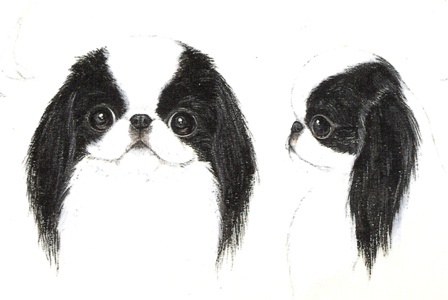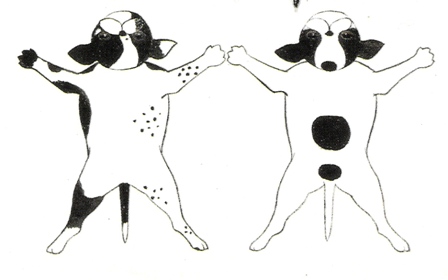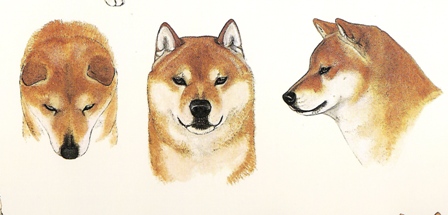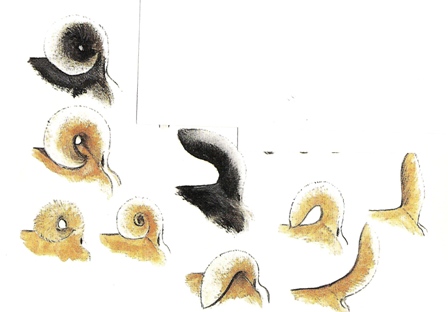JAPANESE BREEDS
Illustrations by kind permission of the JKCs illustrated breed Standards book
AKITA
Since the breed has
been separated I feel much more comfortable in judging the
“American” Akita, as the pull towards what I felt should be the
correct type i.e. Japanese has been lifted with the separation
of the breeds. It is true to say that the two varieties are a
world apart in type. The “Great Japanese dog” as it has been
renamed in FCI countries, and just “Akita” in the UK, is a
heavier, longer and bigger boned dog than its Japanese cousin.
Large, powerful and with much substance and heavy bone. This
should not mean a fat, sluggish dog, but a well covered muscular
guarding type breed that looks able to look after its owner and
his property. They are aloof, and dignified, they can be
dominant, and temperaments need to be kept under control. The
natures of the breed in the show ring in the UK are universally
good, but occasionally abroad; one has to be careful not to over
handle the breed on examination. A large flat skull, forming a
blunt triangle when viewed from above, and free from wrinkle
which is often seen. The eyes relatively small and almond
shaped, with tight eye rims. Strongly erect ears but not big and
certainly never “Shepherdy”. Ears should be carried in line with
the back of the crested, comparatively short neck. In white dogs
flesh coloured pigmentation is allowed, other colours should be
pigmented with black. Body a little longer than high, chest wide
& deep, and the depth half the height at the shoulder. Moderate
angulation both ends, strong muscular thighs and firm hocks. As
the breed can suffer from too little angulation, hocks can
sometimes be seen to be a continuation of the stifle, and be far
too straight. Tight, thick feet, and pasterns only slightly
inclined. A large full tail with full or double curl, always
dipping to or below the backline. A sickle or uncurled tail is
not to be rewarded in the show ring.
A large full tail with full or double curl, always
dipping to or below the backline. A sickle or uncurled tail is
not to be rewarded in the show ring.
< The Top four tails are correct for both breeds, with the American Akita also allowed the third from right dipping down the flank.
Movement is powerful and fluent, with the back remaining absolutely level. Only a moderate stride of course, and a long exaggerated stride in profile is entirely wrong. The Akita coat is a delight. The outer coat coarse, and standing off the body, with the thick plush undercoat soft and dense. Any colour allowed, but they should be brilliant and clear, including brindles and pintos. With dogs up to 28 inches and bitches to 26 inches they are one of the most imposing & impressive members of the dog world, and regularly win top awards.
JAPANESE AKITA INU

Of all the Japanese breeds I feel the closest affinity with the Akita Inu, the lighter more athletic build, the shorter proportions of body and the distinctive head and ears , are very different to the “American” Akita. They are in essence a giant version of the Shiba Inu, and no one would go far wrong in judging them that way.
The colours are restricted to white, brindle and red, Numbers two three & four on the top row. with the red also allowing the red sesame.
The standards are very similar, the head should be triangular, with a blunt muzzle, but the whole head is smaller and the lips tighter, and muzzle lighter, than the Akita. The eyes nearly always show the small almond shape set somewhat obliquely, Ears are quite different, (although similar in the standard). They are set a bit further apart, smaller and often more inclined forward than maybe they should be, but it is a characteristic of the breed. Well boned forelegs and moderate angulation gives a vigorous and moderate length of stride. In a lot of FCI countries where I have judged the breed, the stifles are far too straight, and tend to give a too stilted Chow like movement in the rear. Tails are thick, full and tightly curled. The perfect tail shows a small hole of light through the center, & can be carried slightly to one side or centrally. Body very slightly longer than high, Level back and broad through the loin. The whole appearance of the breed is of a leggier, lighter framed dog, which looks very active and strong. Size: dogs 25 ¼ -27 ½ bitches 22 ¾ -25 ¼ (64-70 cms) (58-64 cms)
JAPANESE SPITZ
This is a
delightful breed, full of personality, bright and alert, and
showing affection towards all. An extremely versatile breed,
which will happily accompany its owners on a country walk, or
sit quietly on the lap of an elderly person. They should be
robust and playful, and therefore make good children’s pets. The
general appearance is of a moderately built pure white Spitz,
with the tail carried well over the back. It is essential that
the profuse white coat stands off from the body because of its
thick soft undercoat. The body should be firm and yet still
flexible, with the ratio of height to length at 10-11.

I would wish a moderately broad slightly rounded skull, with the muzzle about two thirds the length of the distance between the well defined stop and the occiput, tapering nicely.
< The ears are a distinctive feature and should be perfectly erect, not incline in or out and resembling a piece of cut bamboo at the tips.
All pigment should be black, and the eyes which are set rather obliquely, moderate in size and oval in shape. Too short a neck cannot accommodate a thick ruff and can make the dog look too stuffy, so a medium length here is best, but it is certainly not a long neck. As the gait of the Jap Spitz is light, nimble and energetic, the angulation both ends is not excessive, enough to give front extension but not to any great extent, matched by the hind gait of course. Chest broad & deep, reaching to the elbows, a short level back, and a broad firm loin. The croup falls away slightly allowing the tail to lie properly. The tail should always be carried over the back, set high of a medium length. The perfect tail according to the Japanese, should be centrally set, just touch the back and certainly never curl to one side or have a kink at the end. The coat when at its best is straight & stand off; a lot have silver tips which is especially pleasing. Size has changed over the years and the new sizes reflect the differences between dogs and bitches. 11 ¾- 13 ½ for the girls and 13 ½ - 14 ½ for the boys.
JAPANESE CHIN
The Chin is such an
elegant aristocratic breed, they look as if they belonged to the
noblest families in Japan, and I was greatly honoured to judge a
Chin specialty in the country of origin, and see the breed in
its homeland. The Japanese breeders set great store by beauty of
markings, and the correct shape of head.
 The head should be a
series of crescents, the nose set between the eyes, the broad
skull rounded in front and between the ears, but not a domed
head like the King Charles spaniel. The muzzle short, wide and
nicely cushioned, with level jaws. Eyes are perhaps the most
distinctive feature of the whole toy group. Large dark set wide
apart, and showing some white in the inner corners, which gives
the characteristic look of astonishment to the breed. Not all
show this most important point, which is a great pity. Not too
long a neck, but carried proudly. Fine slender legs, nicely
feathered down to hare feet, untrimmed of course. A good square
compact body, fairly wide in chest, with a good turn of stifle.
No mention of forequarter angulation, but it should obviously
nearly match the rear. The movement of the Chin is special too.
Stylish, straight & lifting the feet high when in motion, and no
weakness behind.
The head should be a
series of crescents, the nose set between the eyes, the broad
skull rounded in front and between the ears, but not a domed
head like the King Charles spaniel. The muzzle short, wide and
nicely cushioned, with level jaws. Eyes are perhaps the most
distinctive feature of the whole toy group. Large dark set wide
apart, and showing some white in the inner corners, which gives
the characteristic look of astonishment to the breed. Not all
show this most important point, which is a great pity. Not too
long a neck, but carried proudly. Fine slender legs, nicely
feathered down to hare feet, untrimmed of course. A good square
compact body, fairly wide in chest, with a good turn of stifle.
No mention of forequarter angulation, but it should obviously
nearly match the rear. The movement of the Chin is special too.
Stylish, straight & lifting the feet high when in motion, and no
weakness behind.
 A Chin in full coat shows the beauty of the
breed, Long, straight and very silky in texture, showing a frill
at the neck. Markings evenly distributed on cheeks, ears and as
patches on the body. The Japanese judges place well marked dogs
highly, and prefer a saddle of colour in the middle of the back,
a spot over the base of the tail, and very even head and ear
markings. Flecking and too much black on the body are definite
no no’s. colours are B/W or R/W, the red including all shades of
red down to lemon and orange. No height mentioned in the
standard just the daintier the better, and an ideal weight of
4-7 lbs.
A Chin in full coat shows the beauty of the
breed, Long, straight and very silky in texture, showing a frill
at the neck. Markings evenly distributed on cheeks, ears and as
patches on the body. The Japanese judges place well marked dogs
highly, and prefer a saddle of colour in the middle of the back,
a spot over the base of the tail, and very even head and ear
markings. Flecking and too much black on the body are definite
no no’s. colours are B/W or R/W, the red including all shades of
red down to lemon and orange. No height mentioned in the
standard just the daintier the better, and an ideal weight of
4-7 lbs.
The dog on the left is incorrectly marked >
JAPANESE SHIBA INU
“Small, well
balanced sturdy dog of Spitz type” describes the Shiba extremely
well, add to this the marvellous feel of a dog in full coat and
you have one of the most attractive breeds to grace our
country. A bright active and alert temperament, and lively
friendly nature make this an ideal companion dog too.
 The head
the same shape as the Akita Inu. Blunt and triangular, a
definite stop and obliquely shaped small eyes, muzzle straight
and tapering with tight lips. Parallel planes preferred. Small
pricked ears not set past the outside edge of cheeks, a medium
length of neck, thick and quite muscular. Moderately sloping
shoulders, and a slight but definite bend of stifle. Short loin,
level back with a chest down to the elbows.
The head
the same shape as the Akita Inu. Blunt and triangular, a
definite stop and obliquely shaped small eyes, muzzle straight
and tapering with tight lips. Parallel planes preferred. Small
pricked ears not set past the outside edge of cheeks, a medium
length of neck, thick and quite muscular. Moderately sloping
shoulders, and a slight but definite bend of stifle. Short loin,
level back with a chest down to the elbows.

< Tail very similar to the Akita. The top three tails are correct the others incorrect.
I like the movement of the breed to be elastic, springy, slightly wider in front than in rear, and to look able to turn on a “Yen”. The colours, clear red, Red Sesame, (with an even overlay of black guard hairs) B/T or white. The reds to have white markings as eye spots, cheeks, under jaw and forechest
Zena Thorn Andrews